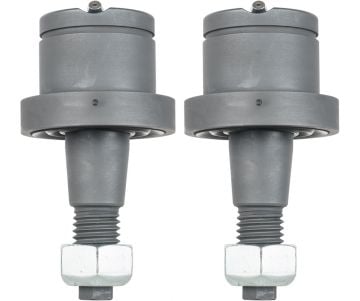Carli Suspension
Carli Extreme Duty Lower Ball Joints 03-13 Dodge Ram 2500/3500
Couldn't load pickup availability
2003, 2004, 2005, 2006, 2007, 2008, 2009, 2010, 2011, 2012, 2013
Carli Extreme Duty Ball Joints are designed, tested, and proven to be the last set of ball joints you'll ever buy. Featuring a unique, proprietary design that literally had years in the making, these ball joints will deliver a noticeable improvement that can be felt all the way at the steering wheel and will outlast the rest of your drivetrain.
The Factory Ball Joints are made up of a lower ball joint and upper floating king-pin. The upper ball joint is designed as a pivot point determining the axis on which the knuckle will move and thus, only sees a lateral load. When you cut into the factory ball Joint, you find a sealed housing, sleeve, pin and boot. The upper cavity stores the grease from the factory and allows the ?hat? of the pin to float up and down as the knuckle raises and lowers through the steering cycle. The ?hat? of the pin does not make contact with the housing, it only prevents the pin from pulling out the bottom of the housing. As the hat of the pin doesn?t contact, there?s a coated sleeve that isolates the pin from the housing and it?s vertical surface is the only wear surface for the upper.
The lower ball joints are the true ball joints in the AAM design. The spherical lower is a ball and socket design allowing lateral misalignment (unlike the king-pin upper). Because the design tracks the knuckle on an imperfect axis, the spherical lower is required to allow the knuckle to move freely with only a slight vertical travel through its steering cycle. By design, the lower factory joint is a pin isolated from the housing by a nylon material loaded from the top and sealed by a press with a boot to keep out the elements. When this composite liner fails, the ball joint needs to be replaced. It?s the old saying, a chain is only as strong as its weakest link.
Carli's improvement on this design begins with the ability to service the joint. The Zerk fitting is recessed into the top of the joint and protrudes at an angle to be aimed forward and slightly inward to allow access to the fitting without needing to disassemble anything. If you were to open up one of these ball joints, you?ll see no liners of any kind. At the top, a bronze wear surface preloaded by a disc spring, safety washer and snap ring ensures the ball joints wear surfaces are always held tightly together for optimal performance.
Now that the design improvements are clear, how can Carli be so confident in the materials that they feel wear-surface isolation can be eliminated? Carli has tested every possible material and process to land on this final iteration since the inception of these lifetime ball joints in 2007. The process starts with masking. The ball joints are masked, all but the wear surface with a copper plating. Once plated, the ball joints head to carburizing. The carburizing creates an extremely hard surface with a case-hardness (penetrating depth) of 20-25 thousandths. For reference, another process was salt-bath nitride which produced 3 thousandths in a best-case scenario. When the ball joint has completed the carburizing/heat treat, they?re stripped of their copper masking leaving the entire joint heat treated and the wear surfaces incredibly hard. From stripping, they head to dry-lube where the whole joint is coated with a corrosion resistant gray coating to project the joint while the lubricity of the coating pairs with anti-seize and Redline CV2 grease to assist in breaking in the wear surfaces.


